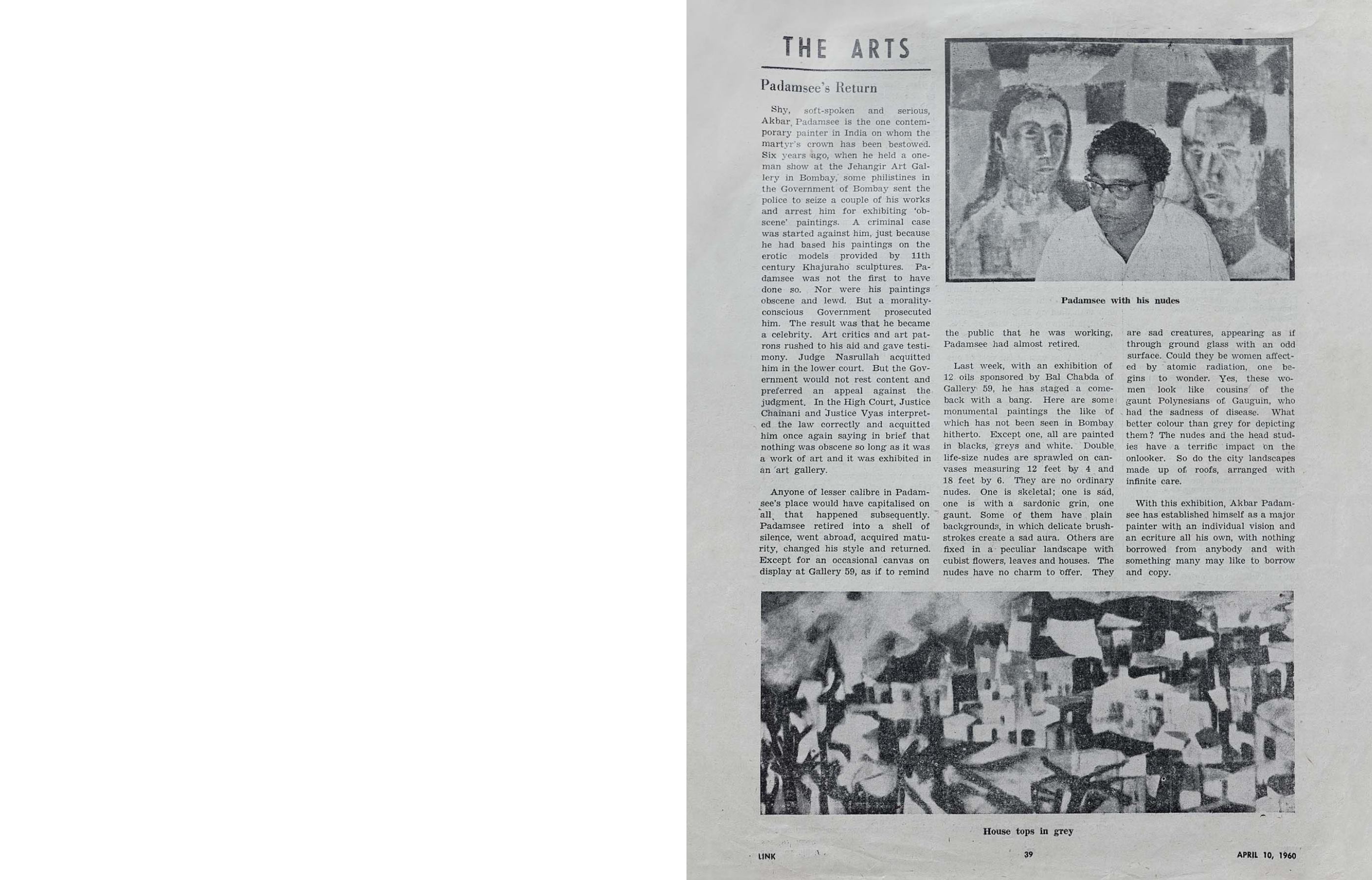

32
Saffronart | Evening Sale
palette now ranged from the soft, pale, lustrous greys of silks
and satins to the deep, dark, ominous greys of the monsoon
skies.” (Bhanumati Padamsee and Annapurna Garimella
eds.,
Akbar Padamsee: Work in Language
, Mumbai: Marg
Publications and Pundole Art Gallery, 2010, p. 180) The
skilful adaptation of varying intensities of grey demonstrates
his mastery over light, texture and tonal variations, making
Greek Landscape
all the more remarkable in its austerity.
Doshi writes of
Greek Landscape
as one of two
“spectacular cityscapes depicting broad panoramic views
of imaginary cities...
Greek Landscape
(pages 292‒93, figure
2) belies its appellation because it, too, is wrought out
of the artist’s imagination. However, its architectural and
topographical specificities do suggest a Mediterranean
locale. The most striking feature of the painting is its
audacious composition which encompasses the city in
a wide, cursive sweep. The city itself, a dense aggregation
of a multiplicity of forms, has, over time, spread from
its central square to the neighbouring hills. The faceted
fabric of the city imparts a sculptural dimension to the
cityscape. The lucid interaction between solids and
voids in the composition reveals the artist’s command
over handling space—a skill he acquired when learning
to sculpt during his student days at the art school in
Bombay.” (Padamsee and Garimella eds., pp. 183, 186)
The art critic for
The Times of India
termed Padamsee ‘The
Painter’s Painter’ andwrote, “Nothing illustrates his growth to
vigorous adulthood more than Padamsee’s one–man show
which opened at the Jehangir Art Gallery on Wednesday.
There are but 12 oils on view, but so overpowering is their
size—ranging as they do from canvases 10 feet by 3 feet
to one enormous composition about 17 feet by 6 feet—
and so outstanding is their quality that even the normally
reticent observer will be deeply moved… all the paintings
are in blacks, greys and whites. Basically cubistic in feeling
they incorporate a degree of naturalism which is somewhat
rare in a man of Padamsee’s austere temperament. Their
brushwork, too, seems to have changed. Instead of the hard
incrusted impasto and the thick lugubrious layers of paint so
familiar in the past, the strokes are light and tender in feeling
with the canvas occasionally peeping through… a landscape
with houses (in spite of its apparent cubistic bleakness)
In 1959, Akbar Padamsee moved from Paris to Mumbai and
worked from his new home in Juhu, creating a small group
of “Grey Works.” In 1960, Gallery 59 owner Bal Chhabda
organised a solo exhibition of these grey paintings at the
Jehangir Art Gallery in Mumbai. Padamsee received glowing
reviews from leading art critics, artists and collectors of
the time. An article titled “Padamsee’s Return” in
The Link
read, “Last week, with an exhibition of 12 oils sponsored by
Bal Chabda [sic] of Gallery 59, he [Padamsee] has staged
a comeback with a bang. Here are some monumental
paintings the like of which has not been seen in Bombay
hitherto. Except one, all are painted in blacks, greys and
white... The nudes and the head studies have a terrific
impact on the onlooker. So do the city landscapes made
up of roofs, arranged with infinite care... Padamsee has
established himself as a major painter with an individual
vision and an écriture all his own, with nothing borrowed
from anybody and with something many may like to borrow
and copy.” (Staff reporter, “Padamsee’s Return,”
The Link
, 10
April 1960, p. 39) By the late 1950s, Padamsee had already
gained recognition as an artist of international repute,
participating in the Venice Biennale in 1953, and the Tokyo
Biennale and Sao Paulo Biennale in 1959. The Grey Works
firmly established him as one of India’s masters.
Four paintings from the group of twelve canvases—
Greek
Landscape, Reclining Nude, Juhu
, and
Cityscape
—were large,
especially striking works.
Greek Landscape
, an extraordinary
work of monumental scale, with a panoramic view of a
city, attracted particular attention. With an architect’s eye,
Padamsee constructs a city of buildings on an undulating
terrain using different intensities of grey. In the
Sadanga Series
on the artist published in 1964, literary critic Sham Lal writes,
“By restricting himself to greys, like the Chinese masters who
confine themselves to the various shades of black, he strikes
the richest vein of poetry in his art. In the paintings of 1959
and 1960 there is a lyrical intensity which comes from a
passionate love affair. The affair is between the artist and
his art.” (Shamlal,
Akbar Padamsee
, Mumbai: Sadanga Series
by Vakils, 1964, p. 7) Padamsee experimented with shades
of grey corresponding to particular colours until he arrived
at the desired intensity. In her essay “Shades of Grey,” Saryu
Doshi elucidates further: “He discovered that certain greys
appear to tune with blue, others with green, and he decided
to substitute those particular greys for the blues and greens
in his compositions. In this way he succeeded in expanding
his chromatic range and giving it resonance... His grey
A glowing review of Padamsee’s Gallery 59 exhibition showing
Greek Landscape
,
published in
The Link
, April 1960
Image courtesy of Bhanumati Padamsee
33

















